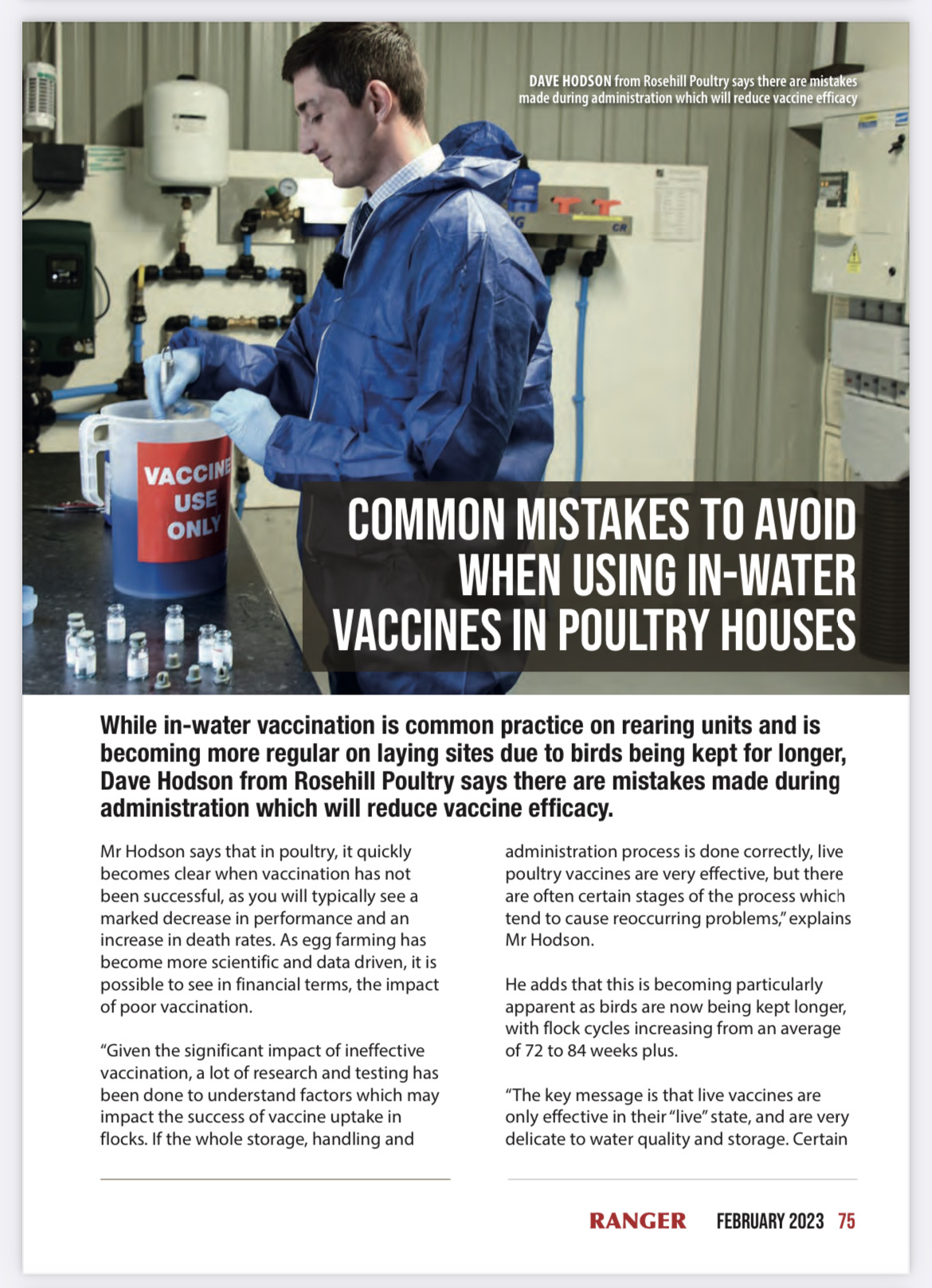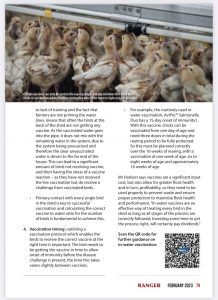
- 21.2.2023
- Education
Common mistakes to avoid when using in- water vaccines in poultry houses – The Ranger
While in-water vaccination is common practice on rearing units and is becoming more regular on laying sites due to birds being kept for longer, Dave Hodson from Rosehill Poultry says there are mistakes made during administration which will reduce vaccine efficacy.
Mr Hodson says that in poultry, it quickly becomes clear when vaccination has not been successful, as you will typically see a marked decrease in performance and an increase in death rates. As egg farming has become more scientific and data driven, it is possible to see in financial terms, the impact of poor vaccination.
“Given the significant impact of ineffective vaccination, a lot of research and testing has been done to understand factors which may impact the success of vaccine uptake in flocks. If the whole storage, handling and administration process is done correctly, live poultry vaccines are very effective, but there are often certain stages of the process which tend to cause
reoccurring problems,” explains Mr Hodson.
He adds that this is becoming particularly apparent as birds are now being kept longer, with flock cycles increasing from an average of 72 to 84 weeks plus.
“The key message is that live vaccines are only effective in their “live” state, and are very delicate to water quality and storage”. Certain vaccines can only be used in the rearing stage, and any mistakes that have been made in vaccination administration during this time often come to light as birds get older and approach end of lay. Therefore the commercial pullet rearers in the UK take great care to vaccinate correctly.


“Many free-range egg producers have realised that it is financially beneficial to vaccinate birds in lay. This is because the hens cell mediated immunity for IB (Infectious Bronchitis) will wear off at about 24 weeks; if another dose is not administered in lay, we can see dips in performance throughout the flock.”
Mr Hodson says that with in-lay vaccination becoming more common, he spends a lot of time with free-range producers showing them the correct methods of vaccination in order to maximise flock health and performance.
He says that when producers have made changes to improve vaccination efficacy, flocks have yielded an extra five eggs per hen over the entire laying duration, which on a 32,000-bird site equates to 150,000 eggs.
“If farmers were being paid £1 a dozen, they would yield an extra £13,000 from vaccinating correctly, so the benefits of maintaining bird health and performance for longer really does extend to producers’ pockets.”
Common mistakes made during in-water vaccination
Mr Hodson highlights four common mistakes made during the in-water vaccination process and gives his advice on how to avoid them:
1. Storage – Storage is critical, as there is great value of the vaccines not only in monetary terms, but in terms of flock health. All vaccines should be refrigerated between 2 and 8 degrees Celsius. If vaccines are exposed to temperatures outside
of these parameters, this can influence vaccine efficacy, so a minimum and maximum thermometer should be installed in the fridge and checked daily.
2. Water sanitising systems – many farms not on mains water have a chlorine dioxide water treatment system fitted, which will destroy the vaccine very quickly. Just 0.2ppm of chlorine, which is standard in mains water and 1/100 th of the standard
drinking water level in sanitised farm water, will result in the vaccine becoming 100 times weaker in the space of 1 hour. This is a common cause of reduced vaccination efficacy. The vaccine becomes less effective or ineffective before the birds receive it;
this is very costly as birds will not be adequately protected despite producers having invested in the vaccine.
- Sanitising systems must be disabled 48 hours prior to vaccination, and Aviblue must be used at a rate of 1 cap per 200 litres of water to ensure vaccine efficacy. It is a combination of dye to visualise successful line priming, and sodium thiosulphate to neutralise sanitising agents.
3. Water to vaccine ratio – There have been instances of producers vaccinating 16,000 birds with three litres of stock solution which is only adequate for the effective vaccination of 2000-3000 adult hens. As 1,000 birds drink up to approximately 60
litres of water over 2-3 hours when mature and in peak production, and therefore 16,000 birds drink roughly 960 litres over the course of 2-3 hours, once the lines have also been primed. On this basis, with a 1% Dosatron, 10 litres of vaccine
solution is required with 5 caps of Aviblue.
– The combination of too little water due to lack of training, means farm managers may not be priming the water lines, resulting in the birds at the back of the shed often not getting any vaccine. As the vaccinated water goes into the pipe, it does not mix with the remaining water in the system, due to the system being pressurised and therefore the clear unvaccinated water is driven to the far end of the house. This can lead to a significant amount of birds not receiving vaccine, and then having the stress of a vaccine reaction – as they have not received the live vaccination but do receive a challenge from vaccinated birds.
– Primary contact with every single bird in the shed is key to successful vaccination and calculating the correct vaccine to water ratio for the number of birds is fundamental to achieve this.
4. Vaccination timing – outlining a vaccination protocol which enables the birds to receive the correct vaccine at the right time is important. The bird needs to be getting the vaccine in time to allow onset of immunity before the disease challenge is
present, the time this takes varies slightly between vaccines.
– For example, the routinely used in-water vaccination, AviPro™ Salmonella Duo has a 15-day onset of immunity. With this vaccine, chicks can be vaccinated from one day of age and need three doses in total during the rearing period to be fully protected. So this must be planned correctly over the 16 weeks of rearing, with a vaccination at 1 week of age, 6 weeks of age and approximately 15 weeks of age.
Mr Hodson says vaccines are a significant input cost, but also allow for greater flock health and in turn, profitability, so they need to be used properly to prevent waste and ensure proper protection to maximise flock health and performance. “In-water vaccines are an effective way of treating every bird in the shed as long as all stages of the process are correctly followed. Investing some time to get the process right, will certainly pay dividends.”